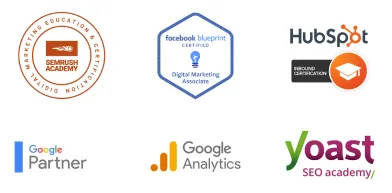TO LEARN IS TO GROW
Learning Center
We do our research and publish our results. Should probably call this the Growing Center.


14 Things You Can Do (Right Now) To Improve Your E-Commerce Marketing Strategy
Your e-commerce marketing strategy is what sets you apart from all the other online brands out there jockeying for position within your space. It’s great to know the basics of marketing, but you’ll also need to bring up your digital marketing game to get a leg up on your competition.
There’s a very good reason why more business owners are now flocking online. E commerce has now given small businesses access to a market they otherwise wouldn’t be able to reach through a regular brick-and-mortar operation.
This also means that with a surge of popularity of online stores and all sorts of similar ventures, having an e-commerce marketing strategy is now more important than ever to anyone selling their products on the internet.
E-commerce marketing, in essence, helps let your customers know about your products. Such that when people go online, whether or not with an intent to browse or to buy, your brand eventually becomes top of mind.
Understandably, developing an e-commerce marketing can take quite a bit of work and can be overwhelming for anyone– startups and seasoned players alike.
But if you must start somewhere, here are 14 action items you can work on today to help your online store stand out head and shoulders above the rest.
1. It Starts With the Shopping Cart
When it comes to building your ecommerce website, there are only three shopping carts you should be considering: Shopify, WooCommerce, and BigCommerce.
All of these three shopping cart solutions are already good in terms of being search engine-friendly out of the box, which is great news for your SEO and paid search initiatives.
They work well even as you ramp up and scale your business. Plus they’re fairly reliable as far as support goes, so you know you have a top-notch team to help you out in the unlikely event that something goes wrong.
2. Invest in SEO
Search engine optimization (or SEO) is going to be one of the most important skills you’d want to have when running an ecommerce business.
Knowing exactly what your customers type into Google’s (or Bing’s) search window to find your products online will sure come in handy, so make sure you do a considerable deal of keyword research so you can incorporate these search terms throughout your site.
Specifically, your product titles, product descriptions, and alt tags for your product photos should be well-optimized. So either get into SEO yourself or hire someone on your team to do all your optimizing for you.
3. Use Photo and Video on Your Product Pages
Remember, your product pages are, in a way, your 24/7 sales team– they’re up and running closing sales for you even as you sleep, even on weekends, and even on holidays.
Having high-quality photos and videos for your products goes a long way towards making your ecommerce site a lot more appealing. With photo and video, take the opportunity to highlight product details, highlight important differentiators, or show your product in action.
While your own smartphone camera might be OK, consider investing in some commercial photography– hiring a photographer to take clean, professional product shots and vignettes for you is a great idea if you have the money to spare.
4. Build Trust and Authority
To paraphrase an old marketing adage: “People do business with brands they like and trust.” If the internet is the new frontier and the wild west for business, you can make your ecommerce store stand out from an already crowded marketplace by leveraging on trust and authority.
One of the best ways to build trust is to showcase reviews from customers who have bought and used (and enjoyed) your products. Take the effort to encourage customers to leave you reviews, as these all go towards building your brand’s credibility.
Another way to help your brand stand out even further: use trust badges. Trust badges serve as proof of verification or accreditation and are invaluable to your conversion efforts.
If and when you can, make sure you prominently display badges from services like TrustArc, PayPal, Verisign, Norton, Intel Security Group, Comodo, Better Business Bureau, and others to show your clients you are a legitimate and trustworthy operation.
5. Optimize Your Checkout Process
After you’ve optimized your product pages, don’t forget to pay special attention to your checkout process as well.
The goal is to minimize shopping cart abandonment. And so with this in mind, make your checkout process as painless and quick as possible. One of the best things you can do is simplify your checkout page. Take away all unnecessary fields so your buyers don’t get turned off by the amount of information they need to give you before finally completing the sales transaction.
Maybe you can have your customers create an account beforehand so they can log in to your site, or even better, use their Google or Facebook account to log in. This way, you can have a very simple checkout page that only needs to ask for payment details and shipping details.
6. Use Google Merchant Center
Google Merchant Center was specifically built to help online stores like your own to connect with millions of potential buyers looking for items every minute and every hour on Google.
Upon signing up for a Google Merchant Center account, you can then upload your product data to enable millions of shoppers to see your online and in-store inventory. Edit it whenever you want, so shoppers always see the right information in your ads.
Focus on optimizing your product feed, which means you’ll want to pay attention to putting in the right keywords into your product title and product description, and making sure all your product information is comprehensive and relevant to your target market.
With Google Merchant Center, you’re creating a product feed in a format Google likes, and as such, the search engine will prefer to display products optimized this way to the right people at the right time.
7. Build Your Social Media Presence
Social media is going to be key for your online marketing efforts as well. After all, your potential customers are most likely on social media, and so engaging them as they’re going through their feeds goes a long way towards keeping you top-of-mind.
This means you need to regularly develop content relevant to your target audience, which could include links to your products and special limited-time promotions or offers. You can also encourage further interaction by diligently responding to your audience’s comments and messages on your page.
Facebook is still by far, the most popular social network in terms of sheer volume. But Instagram is experiencing tremendous growth, and YouTube remains strong and steady especially if you have lots of video content to share. Use Twitter for product news and updates, and Pinterest for visuals, guides, and infographics.
There are more social media platforms out there, but you don’t have to be on all of them; just pick out the three you feel are most relevant to your e-commerce marketing campaigns. Eventually, you’ll want to build up your community to as many followers as you can, as this greatly adds to brand awareness, traffic towards your site, and ultimately, more sales.
8. Optimize Your Ads on Google Shopping
Google Shopping is another online service developed by Google in response to the popularity of e-commerce operations.
In a way, it’s a more specialized form of Google Adwords. Google Shopping ties in with your Google Merchant Center account, drawing the information you have on your products there when it displays your ads.
For sure, you’re going to want to invest in advertising on Google, but part of your e-commerce marketing strategy is that you also keep track of the revenue generated by each of your products with ads running on Google Shopping.
What you’ll want to do is shift your ad spending away from ads that aren’t doing so well, and put more ad spend on your products that are performing well on Google Shopping. This way, you help further maximize your ROI over time.
9. Run Facebook and Instagram Ads
The beauty of Facebook and Instagram ads is that you can be super targeted in terms of gender, age group, location, even down to interests, income level, and so forth.
Facebook and, by extension, Instagram advertisements are great for building awareness. When people don’t know yet what product or service they’re going after (for example, organic pet food), you can target everyone on Facebook who’s interested in pets and organic products, and show them a cool new product they’re not yet familiar with.
As long as you know your target audience, you can be certain your advertisements get displayed on their feeds, so you can be really efficient when it comes to your marketing efforts.
On one hand, you will be having your organic brand-building efforts on social media (see above); this will take care of your brand awareness over the long-term.
On the other hand, investing in ads (specifically on Facebook and Instagram) gives your brand a nice short-term boost. You can run campaigns that can help funnel new leads towards your website, build your online following, introduce a special promotion.
10. Recover Abandoned Shoppers
It is expected that not everyone who goes into your e-commerce site converts to a sale.
So for those who’ve bounced on you (for whatever reason) just before completing their transaction, consider creating a custom email marketing campaign just for them. Encourage them to complete their purchase on your site through an incentive, a discount, or a freebie of sorts.
Another tool you might want to consider using for your site is Hello Bar— a tool to help you collect names and emails of your visitors just before they leave your e-commerce site.
This way, you can continue to build your email list of interested leads. They might not decide to buy now, but you can definitely get in touch with them later with a special email campaign to make sure you stay top-of-mind for later on.
11. Run Dynamic Retargeting Campaigns
You can recover even more leads who have bounced out of your site by running dynamic retargeting campaigns via the Google Display Network..
When visitors leave your site and go about their usual browsing online, they can still see banner ads for your products pop up every now and then. Retargeting allows you to stay top-of-mind with your target market, so when it’s finally time for them to buy, they think of you first.
You can also run retargeting campaigns for Facebook and Instagram. This way, you can go after leads that may normally have been just trickled out of your sales funnel. Through dynamic retargeting, you have a chance to get all these missed opportunities to bring a lot more sales back to your business.
12. Automate Your Email Marketing
As far as e-commerce marketing goes, quite possibly the most-neglected aspect is email marketing.
Many online brands throw in a lot of money into moving leads down the sales funnel to make that first purchase, but not a lot continue to market to those same people to encourage repeat business.
Your email marketing strategy should cover several campaigns, with customized pitches and offers for different segments of your market. Some can be geared towards retargeting (as mentioned above), while others can be angled towards customers who made specific purchases, or even for customers from a particular neighborhood.
There are many creative ways to use email marketing to build your business further. From encouraging customers to leave reviews, to offering gift suggestions for the holidays, or keeping your following up-to-date with your latest blog articles, email marketing should always be a mainstay of your overall e-commerce marketing strategy.
13. Consider SMS or Messenger Marketing
Just like email marketing, mobile marketing via SMS or instant messengers is also often neglected.
With more people glued to the screens of their smartphones now, your customers are more likely to open a message that has arrived via SMS or any other similar messaging service rather than email.
Messages via smartphone can link to a special offer on your e-commerce site, so interested leads can just tap on the link and get directed to a landing page on your site. This is a great tactic to employ particularly on slow days or slow seasons to encourage a bit more business.
Another great tip is to create a “VIP Circle” or a special membership club where customers can get exclusive deals. This way, you can create a banner ad on your site to encourage visitors to leave you their mobile number. You should reward the opt-in action with an incentive of sorts, like a voucher or a discount to make your customers feel special.
14. Leverage on Subscriptions
Another way to encourage repeat business for your online store is to offer subscriptions.
Particularly for consumable items, consider putting together an option where customers can subscribe to a monthly delivery of products. There’s a reason why companies like Dollar Shave Club and so many others have done so well.
Bonus Tip: Create a Referral Program
Another tip worth considering for your e-commerce marketing strategy is this: develop a referral program.
People buying from your site are likely to know other people who might have the same problem, and who might be in need of the solution offered by your products.
Creating a referral program not only incentivizes customers to spread the good word about your business, it’s also a great way to bring in even more hot leads for your online store.
Keep in mind, however, that a successful referral program must incentivize both the customer giving the referral as well as the new customer who has accepted the invitation to do business with you.
To help you get started on your own store’s referral campaign, there are tools available online such as ReferralCandy and many others.
A Final Word About Your E-Commerce Marketing Strategy
A proper e-commerce marketing strategy will help give your online store a leg up on your competition.
E-commerce marketing draws from a number of disciplines:
A bit of web design
Search engine optimization
Social media marketing
Email marketing
Mobile marketing
Content marketing
Customer service
Relationship management
Starting with the tips mentioned above, you can take your e-commerce marketing initiatives even further as you gain a better understanding of what your brand needs to better connect with your target audience.
A proper e-commerce marketing strategy, as you can see, when properly implemented, exists to support your sales efforts. Through a bit of creativity and relationship-building, you should be able to maximize not just your efforts at lead generation, but your conversion optimization as well.
Built for Growth. Backed by 25 Years of Trust.
For over two decades, LOJO has been a trusted partner to hundreds of businesses just like yours. Whether working directly with owners, managers, teams, or boards of directors, our goal remains the same: to be a reliable and results-driven asset to your business.
Over the years, we’ve carefully built a team of experts—each selected for their unique skills, strengths, and personalities. Our clients choose LOJO because they know we genuinely care about their success.
And after 25 years of helping businesses grow, we’re more committed than ever.


Built for Growth. Backed by 25 Years of Trust.
For over two decades, LOJO has been a trusted partner to hundreds of businesses just like yours. Whether working directly with owners, managers, teams, or boards of directors, our goal remains the same: to be a reliable and results-driven asset to your business.
Over the years, we’ve carefully built a team of experts—each selected for their unique skills, strengths, and personalities. Our clients choose LOJO because they know we genuinely care about their success.
And after 25 years of helping businesses grow, we’re more committed than ever.




Matthew Rogers, President
iProspect Check
After spending several months reviewing multiple proposals from several different companies we engaged LOJO to develop a new website that represents our company effectively. We worked initially with Stephen Platte who helped create the scope of the project. Stephen was knowledgeable and always followed up with me on time and as promised.
He "closed the deal" for LOJO with his professionalism, service orientation and easy going approach. Once we signed the contract we were introduced to Jay Kelly who would be the creative lead for LOJO. This was the most challenging part of the project for my company, as there was no shortage of ideas from our side. Jay managed the project flawlessly, and once we had all agreed to the design, Jay introduced us to Eric.
Eric Lay is one of the founders of LOJO. Eric took the design we had developed and brought it to life. We delivered content as quickly as he requested it. Eric kept the project on task and we responded by exceeding every deadline for content. In turn, once provided, literally not a day went by that Eric didn't add the content and take the next step. In just a few weeks we launched our new website. Eric is a pleasure to work with.
His positive attitude and consultative approach really enhanced the experience and made a big difference for us in the outcome of our project. We would welcome you to visit our website to take a look at the quality work of LOJO. We are very pleased with LOJO and look forward to working with them in the future as we pursue an aggressive SEO strategy."
After spending several months reviewing multiple proposals from several different companies we engaged LOJO to develop a new website that represents our company effectively. We worked initially with Stephen Platte who helped create the scope of the project. Stephen was knowledgeable and always followed up with me on time and as promised.
He "closed the deal" for LOJO with his professionalism, service orientation and easy going approach. Once we signed the contract we were introduced to Jay Kelly who would be the creative lead for LOJO. This was the most challenging part of the project for my company, as there was no shortage of ideas from our side. Jay managed the project flawlessly, and once we had all agreed to the design, Jay introduced us to Eric.
Eric Lay is one of the founders of LOJO. Eric took the design we had developed and brought it to life. We delivered content as quickly as he requested it. Eric kept the project on task and we responded by exceeding every deadline for content. In turn, once provided, literally not a day went by that Eric didn't add the content and take the next step. In just a few weeks we launched our new website. Eric is a pleasure to work with.
His positive attitude and consultative approach really enhanced the experience and made a big difference for us in the outcome of our project. We would welcome you to visit our website to take a look at the quality work of LOJO. We are very pleased with LOJO and look forward to working with them in the future as we pursue an aggressive SEO strategy."

Matthew Rogers, President
iProspect Check
The team at LOJO were wonderful to work with. They are well organized and very patient as we worked through our marketing strategy and developed a well thought out and clear action plan at a reasonable price. We will definitely be back for our future campaign needs."

Jon Crosby, Founder
Dazil

